
Fliegerhorst 1/72 Comet I
| KIT #: | |
| PRICE: | $135.00 SRP |
| DECALS: | Two options, BOAC and South African Airways |
| REVIEWER: | Tom Cleaver |
| NOTES: | Resin |

| HISTORY |
Looking back, I realize just how fortunate I was to be an air-minded
son of an air-minded father, growing up in 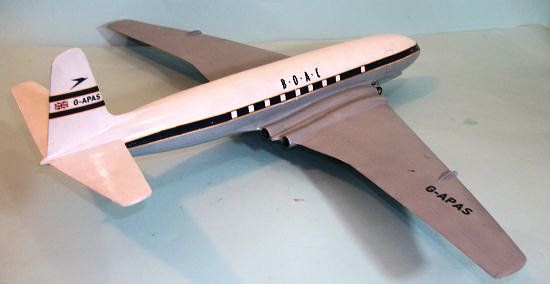 public relations discomfort of
the Air Force), the Lockheed Constitution with its “bug eye” pilots’
canopies, the Super Constellation, and many others.
public relations discomfort of
the Air Force), the Lockheed Constitution with its “bug eye” pilots’
canopies, the Super Constellation, and many others.
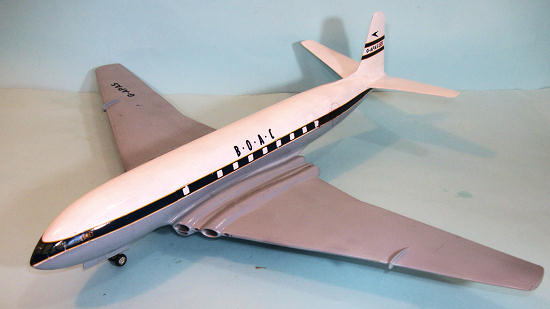 engines (since they owned
them) to power what later became known as the Flamingo.
By the end of the war, when access was gained to German aeronautical
research, thought was given to a tailless design for 20+ passengers.
The D.H. 108 Swallow, in which Geoffrey de Havilland was killed, was
a one-third scale airframe test of the possible design.
Eventually, a more mainstream design was settled on.
Weight soared during construction, and when the Comet I first flew in
1949, powered by four Ghost 103 engines, its cruising speed was nearly 100
mph less than originally estimated, only 450 m.p.h.
This was still a good 200 m.p.h. faster than the piston-powered
competition, and design progressed on the Comet 3, which would be longer and
powered with the
engines (since they owned
them) to power what later became known as the Flamingo.
By the end of the war, when access was gained to German aeronautical
research, thought was given to a tailless design for 20+ passengers.
The D.H. 108 Swallow, in which Geoffrey de Havilland was killed, was
a one-third scale airframe test of the possible design.
Eventually, a more mainstream design was settled on.
Weight soared during construction, and when the Comet I first flew in
1949, powered by four Ghost 103 engines, its cruising speed was nearly 100
mph less than originally estimated, only 450 m.p.h.
This was still a good 200 m.p.h. faster than the piston-powered
competition, and design progressed on the Comet 3, which would be longer and
powered with the
As the world's first jet airliner, the Comet heralded an opportunity
for British commercial aviation to regain the ground lost during the Second
World War and perhaps get a jump on the competition.
All the major American airlines were definitely interested in buying
Comets. DeHavilland had the jump on Boeing and Douglas, who were both
several years from flying the first prototypes of their jet airliners.
The company expected to “make hay while the sun shines.”
Unfortunately, the Comet’s potentially-bright future abruptly ended
after a series of fatal accidents. In the first two years of operations, six
Comets crashed.
The first two
were the result of poor design of the wing leading edge, which was quickly
changed. However, in 1954 two aircraft were destroyed at cruising altitude
by explosive decompression resulting from what was later determined was
accelerated metal fatigue of the airframe due to the frequent pressurization
and de-pressurization, leading to cracks in the corners of the large square
passenger windows.
After the
second crash, the Comet was grounded. Unfortunately, the loss of confidence
in the type meant that the Comet never regained its place as the premiere
jet airliner, with the fully-redesigned Comet 4 only making the first
successful full-passenger load non-stop trans-Atlantic flight in the fall of
1958, a matter of weeks before Pan American started regularly doing the same
thing with the much more advanced Boeing 707 which had been developed and
flown during the intervening years since the grounding of the Comet I.
Britain’s chance to dominate international air travel became a dream that
never came to pass.
| THE KIT |
Fliegerhorst of
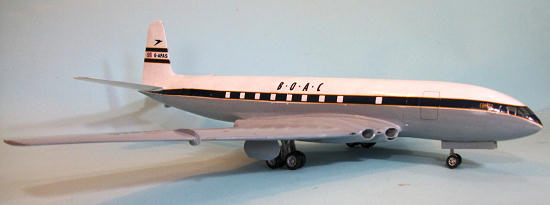
| CONSTRUCTION |
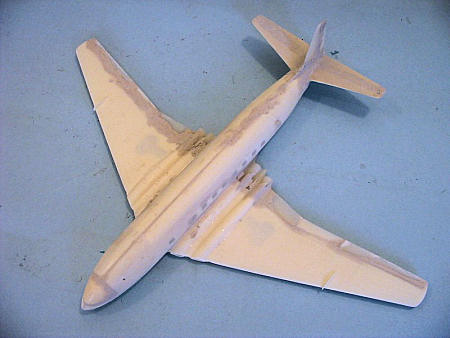 As I first thought, the kit went together fairly quickly, though
closer association with the parts led me to see how really primitive the
castings were, and how ill-fitting the parts were.
It was clear at the outset that only a fool would try to build it
with the vacuformed cockpit windshield and open windows, so the solid nose
was used at the outset and the cabin windows filled in. Once assembled, the
model obviously needed putty.
Everywhere.
I puttied and
sanded and puttied and sanded and puttied and sanded and puttied and sanded.
Much of the surface detail was gone and it was still not a model with
smooth surfaces like an airplane.
As I first thought, the kit went together fairly quickly, though
closer association with the parts led me to see how really primitive the
castings were, and how ill-fitting the parts were.
It was clear at the outset that only a fool would try to build it
with the vacuformed cockpit windshield and open windows, so the solid nose
was used at the outset and the cabin windows filled in. Once assembled, the
model obviously needed putty.
Everywhere.
I puttied and
sanded and puttied and sanded and puttied and sanded and puttied and sanded.
Much of the surface detail was gone and it was still not a model with
smooth surfaces like an airplane.
At that point I put the model on the shelf of doom.
Six months later it went to the real shelf of doom at the back of the
garage.
And sat there for six
years.
Out of sight, out of
mind.
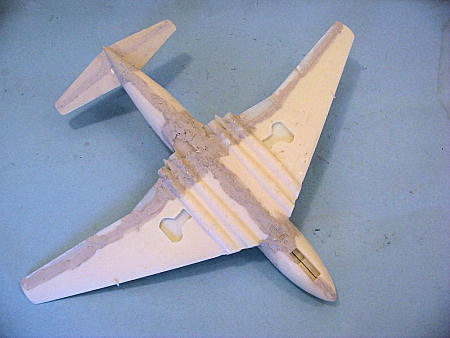
By now I had started using Tamiya on some projects, so I slathered
that on over the engine nacelles and the wing-fuselage joint.
Letting it set up thoroughly over a week, I managed to go through
several sanding sticks and finally get the fuselage smooth.
Then I dropped it and the tail came off.
There was a week while the model’s life hung in the balance as I
considered finally chucking it.
Then in a burst of I-don’t-know-what, I glued the tail back on, puttied it
again and sanded it smooth.
This time I also had to repair the dorsal fin to the vertical stabilizer.
I also repaired the wing fences since those had broken long ago.
| COLORS & MARKINGS |
The model was given several coats of Tamiya grey primer from the
rattle can, sanding after each to correct all the things that still needed
correcting.
The primer is thick
enough that after about the sixth
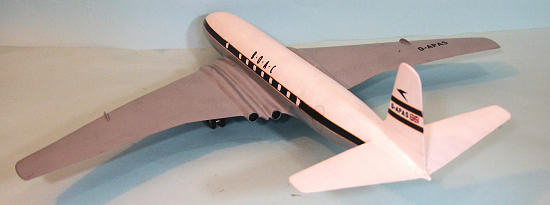 coat I realized I had a pretty nice smooth
finish, and left it at that.
I
then mixed up some Tamiya Light Grey and Flat White to get the “dove grey”
color of G-APAS and painted that overall.
I gave that a coat of Future, and then painted the upper fuselage
with Tamiya Gloss White.
coat I realized I had a pretty nice smooth
finish, and left it at that.
I
then mixed up some Tamiya Light Grey and Flat White to get the “dove grey”
color of G-APAS and painted that overall.
I gave that a coat of Future, and then painted the upper fuselage
with Tamiya Gloss White.
| FINAL CONSTRUCTION |
| CONCLUSIONS |
This is definitely one of the dodgier resin kits I have ever run
across, to put it as politely as possible.
Building it made my ten-rounds-no-holds-barred battle ro yale with the
Collect-Aire P-59A seem like a romp in the park in comparison.
For poor fit and dodgy molding, it’s right up there with that kit,
the Aviation USK 1/48 PBM Mariner, and the Alpha Flight
yale with the
Collect-Aire P-59A seem like a romp in the park in comparison.
For poor fit and dodgy molding, it’s right up there with that kit,
the Aviation USK 1/48 PBM Mariner, and the Alpha Flight
Since the publication of
this review, Jessica Cooper contacted me and told me there is a 1/72
vacuform-resin kit of the Comet I by Welsh Models. She referred me to her
article on building it at Kitmaker.com's Aeroscale site, and it really does
look like a good kit that will produce a worthwhile result. If you really
want a Comet I in 1/72 scale, I suggest you go that route. See it here:
http://aeroscale.kitmaker.net/modules.php?op=modload&name=Sections&file=index&req=viewarticle&artid=4286.
Be advised that the page is heavy with adverts and watermarks.
Tom Cleaver
August 2012 Thanks to If you would like your product reviewed fairly and fairly quickly, please contact the editor
or see other details in the
Note to
Contributors.